Godzilla Conquers the Globe:
Japanese Movie Monsters in International Film Art
Exhibition Room #2: Rare Book Reading Room
From Folk Monsters to Mass Monsters
C. V. Starr East Asian Library, Columbia University, February - December 2004
Curated by Gregory M. Pflugfelder with the assistance of Yoshiko Fredisdorf, Ria Koopmans-de Bruijn, and Derek
Lam
Exhibit map, Room #2:
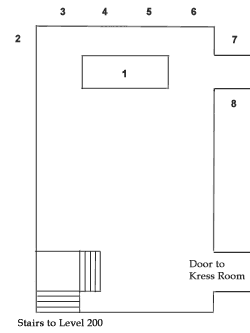 Godzilla is only one of the most
recent among a long line of monstrous creatures
that have populated the Japanese cultural imagination
over the centuries. The earliest examples of recorded
folklore, indeed, the oldest surviving written texts
in Japan, describe such fabulous beings as eight-tailed
serpents, fearsome "dirt spiders," and sea-dwelling
dragons as part of the nation's mythic past. Medieval
tale-tellers added to this monstrous repertory,
as did the writers and artists responsible for the
flourishing of print culture from the seventeenth
century. Although the circulation of monster images
became a "mass" industry only with the twentieth-century
advent of film technology, a profitable commerce
in monstrosity had long before developed in Japan's
early-modern cities, embodied in such cultural products
as books, prints, stage productions, and material
commodities for sale. From the late nineteenth century,
this aspect of Japanese popular culture became increasingly
known overseas through the medium of translated
books. Thus, Godzilla was by no means the first
Japanese monster to set foot on foreign soil.
Godzilla is only one of the most
recent among a long line of monstrous creatures
that have populated the Japanese cultural imagination
over the centuries. The earliest examples of recorded
folklore, indeed, the oldest surviving written texts
in Japan, describe such fabulous beings as eight-tailed
serpents, fearsome "dirt spiders," and sea-dwelling
dragons as part of the nation's mythic past. Medieval
tale-tellers added to this monstrous repertory,
as did the writers and artists responsible for the
flourishing of print culture from the seventeenth
century. Although the circulation of monster images
became a "mass" industry only with the twentieth-century
advent of film technology, a profitable commerce
in monstrosity had long before developed in Japan's
early-modern cities, embodied in such cultural products
as books, prints, stage productions, and material
commodities for sale. From the late nineteenth century,
this aspect of Japanese popular culture became increasingly
known overseas through the medium of translated
books. Thus, Godzilla was by no means the first
Japanese monster to set foot on foreign soil.
Display Case 1:
THE HAUNTED I
Some of the most famous images of monsters from Japanese folklore issued
from the fertile imagination of Utagawa Kuniyoshi (1797-1861), one of the
greatest woodblock artists of the nineteenth century. Starr Library owns
an original set of fifty-nine Kuniyoshi prints from the series titled Genjikumo
ukiyo e-awase (Ukiyoe Comparison of the Cloudy Chapters of Genji), which
the artist produced around the years 1845-1846. Nominally, the series takes
as its theme the literary classic Genji monogatari (Tale of Genji;
ca. 1000), devoting at least one image to each of its fifty-four chapters.
However, only the insets at the top of each sheet directly portray episodes
from that tale. The main focus of the prints lies instead on memorable scenes
from the kabuki theater as played by famous contemporary actors. It is speculated
that Kuniyoshi resorted to this subterfuge in order to circumvent shogunal
regulations prohibiting the sale of images of courtesans and actors—the
two main denizens of the "floating world" (ukiyo)—which had
grown stringent in the early 1840s as part of a campaign to uplift public
morality.
Kabuki was the most spectacular form of visual entertainment available to
early-modern Japanese, and drew huge crowds in the nation's prosperous metropolitan
centers. To be knowledgeable about the leading actors and latest plays was de rigueur for the sophisticated urbanite, and even if one lived
in the countryside, one could still gain an appreciation of the stage's
grand spectacle by looking at popular prints, perhaps bought by a neighbor
on a trip to the city. In this sense, woodblock depictions of the contemporary
marvels of the kabuki stage, or of the equally popular bunraku or puppet
theater (properly called ningyô jôruri), may be seen as a precursor
of the film posters that would whet consumer appetites for motion pictures
in the twentieth century. Both kabuki and bunraku, moreover, were enjoyed
in part for their ingenious visual effects, presenting actors who flew through
the air and puppets that suddenly transformed from ordinary humans into
frightening demons. Although celluloid is a Western invention, the visual
trickery and monstrous themes that animated the genre of kaijû eiga beginning in the 1950s had deep roots in Japanese popular culture.
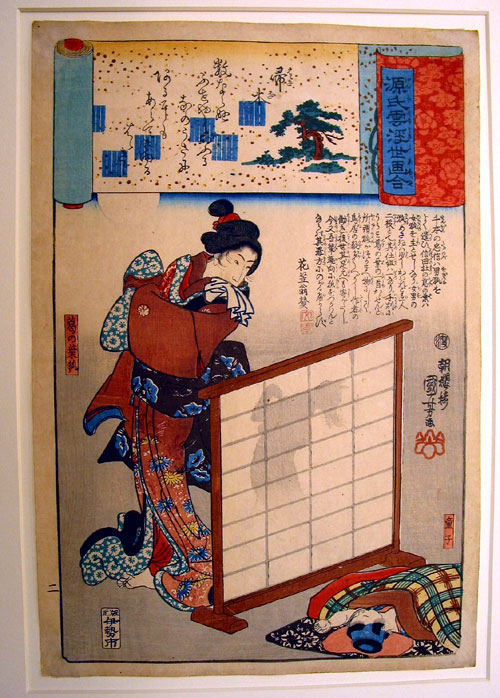 The two prints in the case are in superb condition, and highlight Kuniyoshi's
mastery of color as well as his taste for the bizarre. They were featured
in a 1992 exhibition at the Miriam and Ira D. Wallach Art Gallery titled
"Actors, Courtesans, and Famous Vistas: Japanese Art from Columbia Collections."
The exhibition catalogue introduces the print on the left ITEM
1) as follows:MAGINATION OF UTAGAWA KUNIYOSHI
The two prints in the case are in superb condition, and highlight Kuniyoshi's
mastery of color as well as his taste for the bizarre. They were featured
in a 1992 exhibition at the Miriam and Ira D. Wallach Art Gallery titled
"Actors, Courtesans, and Famous Vistas: Japanese Art from Columbia Collections."
The exhibition catalogue introduces the print on the left ITEM
1) as follows:MAGINATION OF UTAGAWA KUNIYOSHI
In Japan, the fox was believed to have the power of transforming itself into human shape. The legend of the fox-woman Kuzunoha was particularly famous and was even used as a theme for Kabuki plays. Kuzunoha took the form of a woman in order to marry a man who had saved her life in the Shinoda woods. She bore her husband a child, but one day the man saw her while in her fox form. Thus, she had to return to her life in the woods, after bidding an affectionate farewell to her child. The print depicts Kuzunoha taking leave of her son; the shadow on the screen clearly reveals her true animal form.
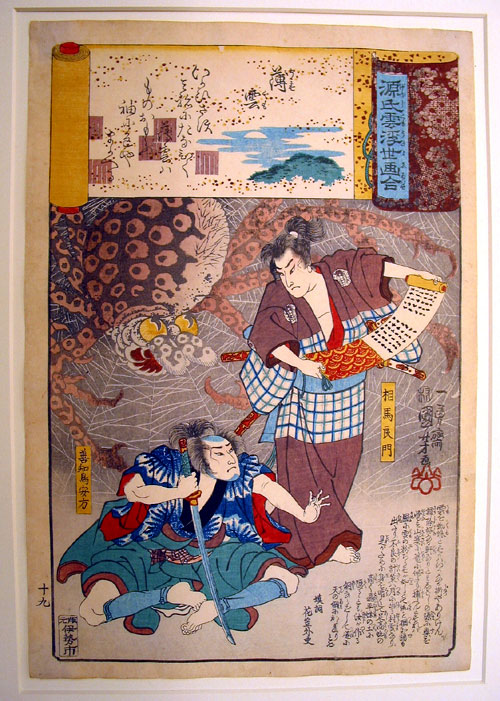 In the print on the right (ITEM
2), Kuniyoshi offers his imaginative interpretation of a "dirt spider" (tsuchigumo), a creature that receives mention as early
as the eighth-century imperial chronicles Kojiki and Nihon shoki.
Some scholars suggest that the term originally may not have referred literally
to an arachnid, but rather to groups of humans on the archipelago who lived
in sunken dwellings (not unlike burrowing spiders) and who resisted imperial
authority. Whatever the case, Japanese artists over the centuries have depicted
spiders as possessing somewhat human features, most prominently a pair of
bulging eyes—rather than the zoologically correct eight—and a
toothy mouth. The same characteristics are evident in the special effects
created to portray Kumonga (a.k.a. Spiega), the giant spider that battles
Godzilla and his son, Minya, in Tôhô's 1967 film Kaijûtô no kessen: Gojira
no musuko (Son of Godzilla, 1969).
In the print on the right (ITEM
2), Kuniyoshi offers his imaginative interpretation of a "dirt spider" (tsuchigumo), a creature that receives mention as early
as the eighth-century imperial chronicles Kojiki and Nihon shoki.
Some scholars suggest that the term originally may not have referred literally
to an arachnid, but rather to groups of humans on the archipelago who lived
in sunken dwellings (not unlike burrowing spiders) and who resisted imperial
authority. Whatever the case, Japanese artists over the centuries have depicted
spiders as possessing somewhat human features, most prominently a pair of
bulging eyes—rather than the zoologically correct eight—and a
toothy mouth. The same characteristics are evident in the special effects
created to portray Kumonga (a.k.a. Spiega), the giant spider that battles
Godzilla and his son, Minya, in Tôhô's 1967 film Kaijûtô no kessen: Gojira
no musuko (Son of Godzilla, 1969). 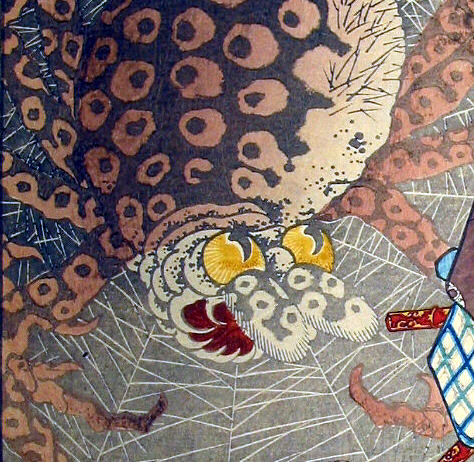
The word kumo has two meanings in Japanese—"spider" and "cloud"—and
it is on this basis that Kuniyoshi makes punning allusion to the "Wisps
of Cloud" (Usugumo) chapter of the classic Tale of Genji that
appears in the print's formal title. The two male figures are Sôma (or Taira)
Yoshikado and Utô Yasukata, famous warriors of the tenth century. The spider
in the background is the spirit of Yoshikado's dead sister, Kochô, whose
name literally means "butterfly"—a far less gruesome insect. The celebrated
playwright Chikamatsu Monzaemon (1653-1725) introduced this metamorphic
twist into the Yoshikado legend in his 1724 play Kanhasshû tsunagiuma (The Tethered Steed and the Eight Provinces of Kantô), written originally
for the puppet theater. The scene, which lends itself to impressive special
effects, was a favorite among both bunraku and kabuki audiences. Art historian
Matthew McKelway notes that a kabuki version of the story was performed
at Edo's Ichimuraza theater in the winter of 1844, just a year or two before
the publication of this print.
Display Case 2:
MANGA AND MANGA 1
The word manga, or comic book, has become part of today's global lexicon
of pop culture. Few who use it probably are aware that the term, written
originally with Chinese characters (![]() )
that literally mean "random pictures," derives from the title of a fifteen-volume
woodblock-printed book that was published during the early nineteenth century
by the artist Katsushika Hokusai (1760-1849). Like its latter-day descendants,
Hokusai's pictorial miscellany featured numerous images of ghosts, monsters,
and demons, and circulated widely among the general populace, enjoyed by
young as well as old. Hokusai's supernatural imagery drew from many sources,
including native folklore, Chinese legend, Buddhist cosmology, and contemporary
popular culture. Starr Library is proud to own several editions of this
classic.
)
that literally mean "random pictures," derives from the title of a fifteen-volume
woodblock-printed book that was published during the early nineteenth century
by the artist Katsushika Hokusai (1760-1849). Like its latter-day descendants,
Hokusai's pictorial miscellany featured numerous images of ghosts, monsters,
and demons, and circulated widely among the general populace, enjoyed by
young as well as old. Hokusai's supernatural imagery drew from many sources,
including native folklore, Chinese legend, Buddhist cosmology, and contemporary
popular culture. Starr Library is proud to own several editions of this
classic.
 Godzilla's twentieth-century creators were deeply influenced by the modern
science of paleontology, but giant reptiles have haunted the cultural imagination
for millennia. Dragons took various shapes and carried many different associations
in Chinese and Japanese traditions. At the middle left of the left page
of ITEM
3, for example, is an amaryô, a dragon that lived in the skies
and was believed responsible for generating rain and thunder.
Godzilla's twentieth-century creators were deeply influenced by the modern
science of paleontology, but giant reptiles have haunted the cultural imagination
for millennia. Dragons took various shapes and carried many different associations
in Chinese and Japanese traditions. At the middle left of the left page
of ITEM
3, for example, is an amaryô, a dragon that lived in the skies
and was believed responsible for generating rain and thunder. 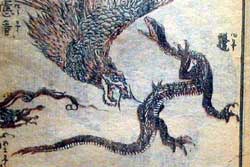 To its immediate
right is the daryô,
a marine variety that, according to one 1795 source, appeared from time
to time in the seas off Kyushu, and might reach a length of ten to twenty
feet. Hokusai's marvelous rendering of an "ash-puffing dragon" in ITEM
4
To its immediate
right is the daryô,
a marine variety that, according to one 1795 source, appeared from time
to time in the seas off Kyushu, and might reach a length of ten to twenty
feet. Hokusai's marvelous rendering of an "ash-puffing dragon" in ITEM
4 incorporates a visual pun: not only does the creature exhale smoke
from its mouth,
incorporates a visual pun: not only does the creature exhale smoke
from its mouth,
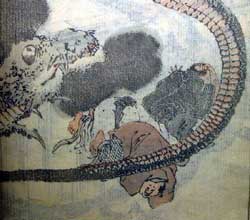 but its tail dips into a tray of tobacco utensils—another form of puffing that involves
ashes. Tobacco had been introduced into Japan by Portuguese missionaries
during the sixteenth century, and was widely enjoyed in Hokusai's time,
particularly in the entertainment quarters.
but its tail dips into a tray of tobacco utensils—another form of puffing that involves
ashes. Tobacco had been introduced into Japan by Portuguese missionaries
during the sixteenth century, and was widely enjoyed in Hokusai's time,
particularly in the entertainment quarters. 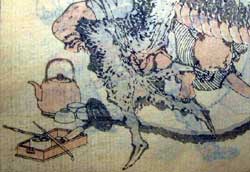 Another old and pervasive association
of dragons in East and in South Asia is with a magnificent undersea realm
ruled over by a serpent deity. In ITEM
5,
Another old and pervasive association
of dragons in East and in South Asia is with a magnificent undersea realm
ruled over by a serpent deity. In ITEM
5, 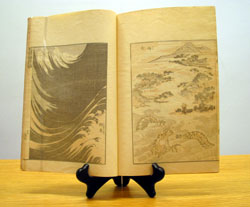 on the right page, Hokusai depicts a "city in the sea," complete
with a swimming dragon,
masterfully giving both the now-you-see-it-now-you-don't air of a mirage.
This particular type of dragon, called a shin,
on the right page, Hokusai depicts a "city in the sea," complete
with a swimming dragon,
masterfully giving both the now-you-see-it-now-you-don't air of a mirage.
This particular type of dragon, called a shin,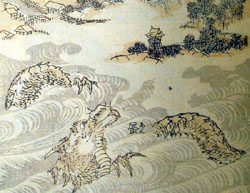 was believed able to
summon up visions of fantastic architecture with a mere puff of its breath.
Coupled with this image on the opposite page is another marine phantom:
"ship
ghosts" (funayûrei), silhouetted almost imperceptibly in white
against a slightly darker background. They are the spirits of dead boatsmen
who continue to haunt their watery grave.
was believed able to
summon up visions of fantastic architecture with a mere puff of its breath.
Coupled with this image on the opposite page is another marine phantom:
"ship
ghosts" (funayûrei), silhouetted almost imperceptibly in white
against a slightly darker background. They are the spirits of dead boatsmen
who continue to haunt their watery grave.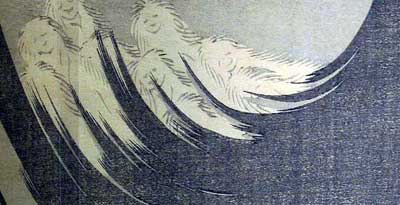
Display Case 3:
MANGA AND MANGA 2
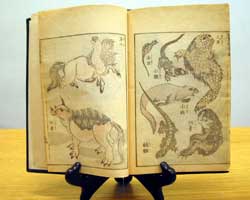 Well into the nineteenth century, Japan bestiaries (encyclopedic representations
of animals) routinely mixed imaginary creatures with actual living ones.
Hokusai's animal prints provide many examples, and even some of the real
species he depicts resemble their zoological counterparts only rather tenuously.
Well into the nineteenth century, Japan bestiaries (encyclopedic representations
of animals) routinely mixed imaginary creatures with actual living ones.
Hokusai's animal prints provide many examples, and even some of the real
species he depicts resemble their zoological counterparts only rather tenuously.
In ITEM 6, a reasonably lifelike sea cucumber (right page, top left), (to its right), seal (directly below), and pangolin (directly below) share their habitat with a more fanciful walrus or "sea horse," here literally imagined as an aquatic equine (left page, top), and a "water rhinoceros," which is a designation that in fact probably referred to a water buffalo (left page, bottom). Meanwhile, a mermaid or a merman (right page, top right) and a water imp (kappa; right page, bottom right) swim not too far away. The "three-eyed [or three-jeweled] turtle" of ITEM 7 is somewhat of a mystery. Could this be a precursor of Gamera, the monster tortoise that Daiei Studios developed in the 1960s in order to rival Tôhô's reptilian star, Godzilla?
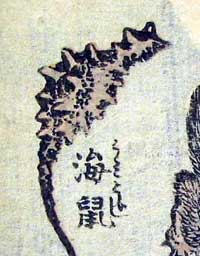 |
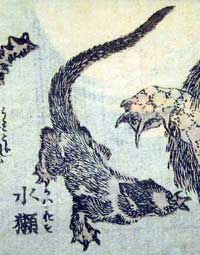 |
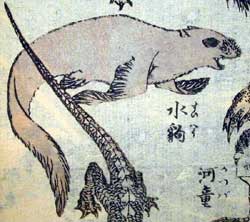 |
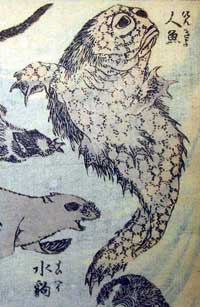 |
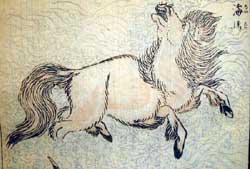 |
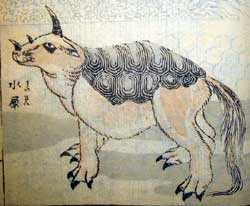 |
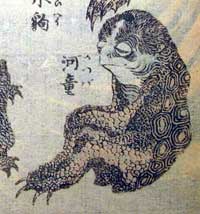 |
Buddhism, which was introduced into the Japanese archipelago during the sixth century, brought with it not only new beliefs but also new creatures of fantasy. One ubiquitous mischief-maker was the oni or demon, which populated the numerous hells of Buddhist cosmology. Demons in Japan can be distinguished by the two horns that grow atop their heads, although judging from ITEM 8 (right page), they sometimes have one or three eyes instead of the usual pair. The owner of another copy on display here, ITEM 9 [DETAIL], seems to have used the image for drawing practice, sketching the outline of a demon on the back of the page. The most effective way to get rid of demons, as ITEM 10 illustrates, is to scatter beans, a custom associated in Japan even today with the beginning of the lunar new year (setsubun).
Display Case 4:
MANGA AND MANGA 3
 In ITEM
11, Hokusai depicts, counter-clockwise from the top left, a ghost (yûrei); the mountain hag Yamamba;
a "baboon"
(hihi); and a tengu or mountain goblin. Ghosts in Japan are more often depicted as female than
male, and noticeably lack feet.
Various legends surround the figure of Yamamba,
an old woman said to live in the mountains with her son Kintarô, the wild
boy.
In ITEM
11, Hokusai depicts, counter-clockwise from the top left, a ghost (yûrei); the mountain hag Yamamba;
a "baboon"
(hihi); and a tengu or mountain goblin. Ghosts in Japan are more often depicted as female than
male, and noticeably lack feet.
Various legends surround the figure of Yamamba,
an old woman said to live in the mountains with her son Kintarô, the wild
boy.
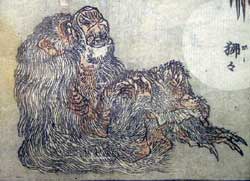 |
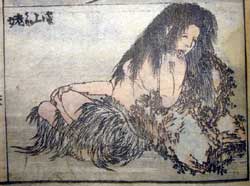 |
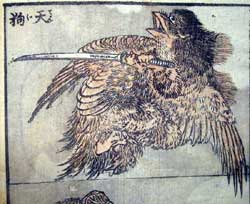 |
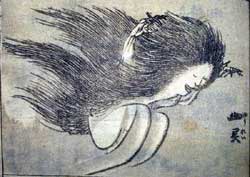 |
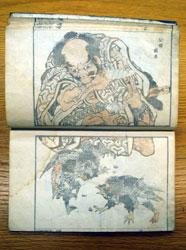 This same son appears as an adult in ITEM
12, identified here with Sakata Kintoki, a warrior active around the
end of the first millennium. For Japanese of Hokusai's day, a baboon was no less fantastic a creature than a dragon or a mermaid, being known
chiefly from continental sources. On the other hand, many might have claimed
to have seen—or at least heard of someone who had seen—a mountain
goblin, which was a prominent figure in native lore. Tengu have
long, sometimes beaklike noses,
clawed feet (as do demons), and are fond of mischief. They are traditionally
associated with mountain hermits as well as with military prowess (notice
the sword in ITEM
11), which makes them apt playmates for the savage-born warrior Kintoki.
This same son appears as an adult in ITEM
12, identified here with Sakata Kintoki, a warrior active around the
end of the first millennium. For Japanese of Hokusai's day, a baboon was no less fantastic a creature than a dragon or a mermaid, being known
chiefly from continental sources. On the other hand, many might have claimed
to have seen—or at least heard of someone who had seen—a mountain
goblin, which was a prominent figure in native lore. Tengu have
long, sometimes beaklike noses,
clawed feet (as do demons), and are fond of mischief. They are traditionally
associated with mountain hermits as well as with military prowess (notice
the sword in ITEM
11), which makes them apt playmates for the savage-born warrior Kintoki.
The early-modern Tokugawa period (1600-1868) in which Hokusai lived and
worked saw an unprecedented flourishing of monster culture and commerce.
Children as well as adults in such urban centers as Edo (today's Tokyo),
Osaka, and Kyoto eagerly consumed, or at least coveted, a wide range of
monster products that were available on the market or from lending libraries.
Among them were picture books (ehon) that paraded an endless variety
of strange creatures to a diversity of "readers" who were not always fully
literate. Hokusai's Manga series offers a prominent example, but
it only appeared many decades after an earlier monster boom in the pages
of the eighteenth-century genre known as kibyôshi ("yellow-cover
books"), and shows clear traces of the latter's influence. This debt is
particularly evident in ITEM
13,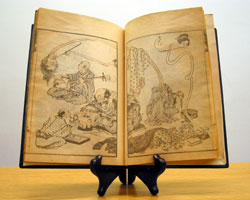 which captures the playfulness and parody typical of popular portrayals
of monsters by predecessors such as the kibyôshi author and illustrator
Santô Kyôden (1761-1816). In this humorous image, Hokusai places two varieties
of monster in a contemporary urban setting. A pair of rokurokubi,
creatures with long, elastic necks, are serenaded by a player of the three-stringed shamisen,
which is an instrument associated with the pleasure quarters, as is the
tobacco that both the rubbernecks smoke. Perhaps the creatures are shown
in bed because it was at night that the rokurokubi's neck was believed
to extend in search of prey. The number of strings on the instrument is
cleverly echoed by the three eyes on the forehead of the figure who faces
the reader on the left page. Known in Japanese as a mitsume or "three-eyes," the creature appears in the ancient lore of China as well
as of the ancient Mediterranean (most famously in Pliny's Natural History).
Hokusai adds an up-to-date, comical touch by showing the monster being fitted
for a pair of spectacles specially suited to his optical needs. Eyeglasses, which were invented in
Italy around the thirteenth or fourteenth century, entered Japan during
the Tokugawa period (1600-1868). Notice the spiderweb
pattern on the three-eyed creature's garb, which adds to his spooky
air.
which captures the playfulness and parody typical of popular portrayals
of monsters by predecessors such as the kibyôshi author and illustrator
Santô Kyôden (1761-1816). In this humorous image, Hokusai places two varieties
of monster in a contemporary urban setting. A pair of rokurokubi,
creatures with long, elastic necks, are serenaded by a player of the three-stringed shamisen,
which is an instrument associated with the pleasure quarters, as is the
tobacco that both the rubbernecks smoke. Perhaps the creatures are shown
in bed because it was at night that the rokurokubi's neck was believed
to extend in search of prey. The number of strings on the instrument is
cleverly echoed by the three eyes on the forehead of the figure who faces
the reader on the left page. Known in Japanese as a mitsume or "three-eyes," the creature appears in the ancient lore of China as well
as of the ancient Mediterranean (most famously in Pliny's Natural History).
Hokusai adds an up-to-date, comical touch by showing the monster being fitted
for a pair of spectacles specially suited to his optical needs. Eyeglasses, which were invented in
Italy around the thirteenth or fourteenth century, entered Japan during
the Tokugawa period (1600-1868). Notice the spiderweb
pattern on the three-eyed creature's garb, which adds to his spooky
air.
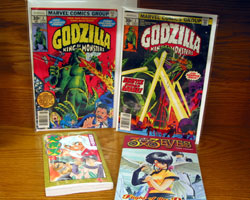 The present-day descendants of Hokusai's Manga are the mass-produced
and mass-marketed comic books known as manga—now an English as well
as a Japanese common noun. Two examples, ITEM
14 and ITEM
15, are on display here, their texts in Japanese and English respectively.
Because Japanese manga typically read from right to left, rendering them
into English often involves reversing the images as well as translating
the words.
The present-day descendants of Hokusai's Manga are the mass-produced
and mass-marketed comic books known as manga—now an English as well
as a Japanese common noun. Two examples, ITEM
14 and ITEM
15, are on display here, their texts in Japanese and English respectively.
Because Japanese manga typically read from right to left, rendering them
into English often involves reversing the images as well as translating
the words.
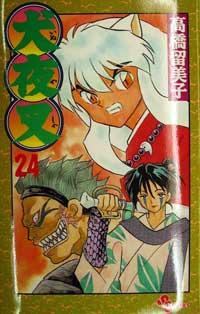 On the cover of ITEM
15 is what Tokugawa Japanese would have called a mitsume or "three-eyes,"
which we have encountered already in ITEM
13. Here the creature is incarnated as a "triclops" hailing from a netherworld
in the vicinity of Tibet. American comic books have different historical
origins from Japanese manga, but they share many features with them, and
on occasion have borrowed from Japanese monster traditions, both new and
old. Stan Lee (1922- ), of Spiderman fame, introduced Godzilla as a Marvel
Comics character in 1977, proclaiming in the first issue (ITEM
16): "Look out, America! The mightiest menace of them all is coming
your way!" The following number (ITEM
17) placed the King of the Monsters atop Seattle's Space Needle, thousands
of miles across the Pacific from his original home.
On the cover of ITEM
15 is what Tokugawa Japanese would have called a mitsume or "three-eyes,"
which we have encountered already in ITEM
13. Here the creature is incarnated as a "triclops" hailing from a netherworld
in the vicinity of Tibet. American comic books have different historical
origins from Japanese manga, but they share many features with them, and
on occasion have borrowed from Japanese monster traditions, both new and
old. Stan Lee (1922- ), of Spiderman fame, introduced Godzilla as a Marvel
Comics character in 1977, proclaiming in the first issue (ITEM
16): "Look out, America! The mightiest menace of them all is coming
your way!" The following number (ITEM
17) placed the King of the Monsters atop Seattle's Space Needle, thousands
of miles across the Pacific from his original home.
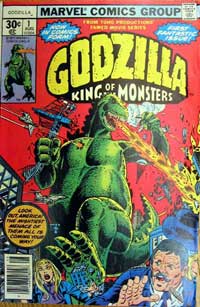 |
 |
Display Case 5:
JAPANESE
MONSTERS ON THE WORLD STAGE (I)
As growing numbers of Westerners began to visit Japan from the latter half
of the nineteenth century, the ghosts, monsters, and demons of Japanese
tradition gained a new audience overseas. One of the earliest stories to
be translated into English was the tale of Momotarô, the Peach Boy. Often
regarded as quintessentially Japanese, the origins of the folktale may in
fact be related to the ancient Chinese belief that peach wood has magical
powers to drive away evil spirits. The tale recounts the adventures of a
boy who is born from a peach found floating in the river by a childless
elderly couple. Accompanied by a dog, a monkey, and a pheasant, Momotarô
subsequently journeys to Oni-ga-shima, or Demon Island, where he vanquishes
a wicked horde of oni led by the fearsome red-hued Akandôji.
 The story first appeared in English in Tales of Old Japan (ITEM
18), an 1871 anthology authored by the British diplomat Algernon Bertram
Mitford (later Baron Redesdale;1837-1916). Mitford had acquired his knowledge
of Japanese folklore while serving as attaché to the British delegation
in Japan between 1866 and 1870, where he witnessed the dissolution of the
Tokugawa shogunate and founding of a modern nation-state.
The story first appeared in English in Tales of Old Japan (ITEM
18), an 1871 anthology authored by the British diplomat Algernon Bertram
Mitford (later Baron Redesdale;1837-1916). Mitford had acquired his knowledge
of Japanese folklore while serving as attaché to the British delegation
in Japan between 1866 and 1870, where he witnessed the dissolution of the
Tokugawa shogunate and founding of a modern nation-state.
 |
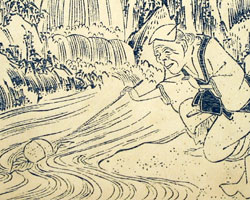 |
I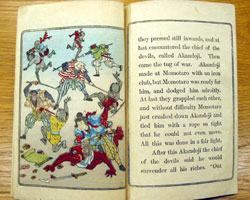 llustrations
"drawn and cut on wood by Japanese artists" accompanied Mitford's text,
and are among the first examples of the hanga (woodblock print) tradition
to be published outside Japan. Another early English rendition was the 1885
children's book Momotaro, or Little Peachling (ITEM
19),
whose Tokyo-based publisher listed the work's translator as "Dabiddo Tamusan,"
presumably a foreign resident by the name of David Thom(p)son. A purely
visual rendering may be found in ITEM
20, which draws on the tradition of kirigami, the art of paper
cutting. Can you find Momotaro's three animal companions?
llustrations
"drawn and cut on wood by Japanese artists" accompanied Mitford's text,
and are among the first examples of the hanga (woodblock print) tradition
to be published outside Japan. Another early English rendition was the 1885
children's book Momotaro, or Little Peachling (ITEM
19),
whose Tokyo-based publisher listed the work's translator as "Dabiddo Tamusan,"
presumably a foreign resident by the name of David Thom(p)son. A purely
visual rendering may be found in ITEM
20, which draws on the tradition of kirigami, the art of paper
cutting. Can you find Momotaro's three animal companions?

Display Case 6:
JAPANESE
MONSTERS ON THE WORLD STAGE (II)
Among early Western translators of Japanese monster lore, Lafcadio Hearn
(1850-1904) was not the first, but he was undoubtedly the most prolific
and perhaps the most widely read. Giving up a modest career in American
journalism, Hearn, who was British by birth, arrived in Yokohama to open
a new chapter in his restless life in 1890. He eventually became a Japanese
citizen, adopting the name of Koizumi Yakumo. Hearn/Koizumi's abiding interest
in the uncanny and the supernatural found expression in ten collections
of essays that he published between 1894 and his death a decade later. His
renderings of Japanese ghost stories form the basis of Kobayashi Masaki's
visually stunning Kwaidan (1964), winner of a Special Jury Prize
at Cannes in 1965. It is not an honor, incidentally, that has befallen any
Godzilla film.
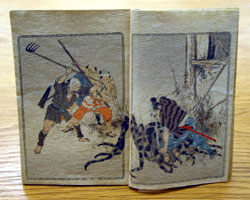 The "Goblin Spider" of ITEM
21 is Hearn's name for the tsuchigumo, literally a "dirt spider." We
have come across this creature already in ITEM
2, as interpreted by the woodblock master Kuniyoshi. In the present
book illustration as well, by an unknown artist, bulging eyes and a voracious
mouth distinguish the monstrous arachnid. The story Hearn relates is one
of many concerning a quartet of legendary warriors at the turn of the first
millenium, led by the valiant general Minamoto Raikô. Among the four retainers
is Sakata Kintoki, the ex-Wild Boy of ITEM
12. In the story, the samurai heroes pursue a bloodthirsty spider to
its cavernous lair, which is hidden beneath the broken-down house shown
in the illustration.
The half-figure of a woman holding a lantern on the book's cover relates to a different story. Lanterns, along with certain other household
objects, have been traditionally associated in Japan with monsters and spirits.
One of the most famous ghosts of the kabuki stage, Oiwa, appears at one
point in the play with a lanternlike visage, and there even was a traditional
spook called the chôchin obake—literally, a "lantern ghost"—who
was little more than a paper lantern with feet and arms. In a preelectrical
society, a light glowing in the dark can quite easily convey a sense of
the uncanny. One thinks, for example, of the natural phenomena popularly
known as "will-o'-the-wisp" and "foxfire" as well as the enduring jack-o'-lantern
of Halloween.
The "Goblin Spider" of ITEM
21 is Hearn's name for the tsuchigumo, literally a "dirt spider." We
have come across this creature already in ITEM
2, as interpreted by the woodblock master Kuniyoshi. In the present
book illustration as well, by an unknown artist, bulging eyes and a voracious
mouth distinguish the monstrous arachnid. The story Hearn relates is one
of many concerning a quartet of legendary warriors at the turn of the first
millenium, led by the valiant general Minamoto Raikô. Among the four retainers
is Sakata Kintoki, the ex-Wild Boy of ITEM
12. In the story, the samurai heroes pursue a bloodthirsty spider to
its cavernous lair, which is hidden beneath the broken-down house shown
in the illustration.
The half-figure of a woman holding a lantern on the book's cover relates to a different story. Lanterns, along with certain other household
objects, have been traditionally associated in Japan with monsters and spirits.
One of the most famous ghosts of the kabuki stage, Oiwa, appears at one
point in the play with a lanternlike visage, and there even was a traditional
spook called the chôchin obake—literally, a "lantern ghost"—who
was little more than a paper lantern with feet and arms. In a preelectrical
society, a light glowing in the dark can quite easily convey a sense of
the uncanny. One thinks, for example, of the natural phenomena popularly
known as "will-o'-the-wisp" and "foxfire" as well as the enduring jack-o'-lantern
of Halloween.
The spider is not the only insect that has over the centuries instilled
fear and awe in many Japanese. Centipedes and caterpillars, too, have been
the target of much revulsion. A court tale of the twelfth century describes
an unconventional young noblewoman who indulges in such unladylike pastimes
as playing with snakes and toads, and notes that her bushy eyebrows look
shockingly "like caterpillars." This sort of cultural disdain for certain
types of insect could easily metamorphose into a screen creature like Mothra.
The centipede, meanwhile, plays a prominent role in a legend concerning
Fujiwara Hidesato, a general famed for quelling the revolt of Taira Masakado
(ca. 903-940), who was the father of the warrior Yoshikado depicted in ITEM
2. 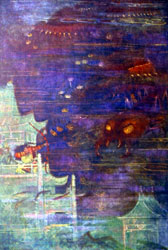 As recounted by the Briton F. Hadland Davis in his Myths and Legends
of Japan (ITEM
22),
a work from 1912, Hidesato slew a "great centipede" that had been tormenting
residents of the region around Lake Biwa. As a reward, the benevolent dragon-king
who lived at the bottom of the lake bestowed upon Hidesato a self-replenishing
bag of rice that would feed his descendants down through the generations.
The illustration was done by Davis's countrywoman Evelyn Paul (1870-1945), whose style was
deeply influenced by the Pre-Raphaelite School of the late nineteenth century.
One last spider may be seen in an illustration from Ancient Tales and
Folklore of Japan (ITEM
23), a 1908 anthology by Richard Gordon Smith (1858-1918), who was a
British animal hunter and—following a bitter marital dispute—a
full-time traveler. The spider is here surrounded by a motley crew of monstrous
apparitions, including a mountain goblin (tengu), a rubberneck,
a dirt
spider, and a monoculus.
As recounted by the Briton F. Hadland Davis in his Myths and Legends
of Japan (ITEM
22),
a work from 1912, Hidesato slew a "great centipede" that had been tormenting
residents of the region around Lake Biwa. As a reward, the benevolent dragon-king
who lived at the bottom of the lake bestowed upon Hidesato a self-replenishing
bag of rice that would feed his descendants down through the generations.
The illustration was done by Davis's countrywoman Evelyn Paul (1870-1945), whose style was
deeply influenced by the Pre-Raphaelite School of the late nineteenth century.
One last spider may be seen in an illustration from Ancient Tales and
Folklore of Japan (ITEM
23), a 1908 anthology by Richard Gordon Smith (1858-1918), who was a
British animal hunter and—following a bitter marital dispute—a
full-time traveler. The spider is here surrounded by a motley crew of monstrous
apparitions, including a mountain goblin (tengu), a rubberneck,
a dirt
spider, and a monoculus.
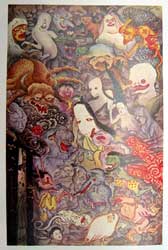 This "Procession of Ghosts" is what Japanese referred to as a hyakki
yakô, literally, a "night procession of one hundred demons." According
to Smith, a certain "Mr. Mo-No-Yuki…drew and painted the illustrations from
sketches of my own."
This "Procession of Ghosts" is what Japanese referred to as a hyakki
yakô, literally, a "night procession of one hundred demons." According
to Smith, a certain "Mr. Mo-No-Yuki…drew and painted the illustrations from
sketches of my own."
English is not the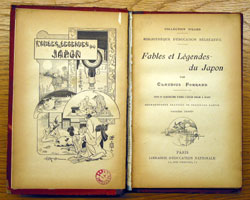 only language through which Japanese monster lore has
been transmitted across the globe. ITEMS 24, 25,
and 26 are translations of Japanese folktales into French, Russian, and Dutch respectively.
As cultural texts—whether folklore or Godzilla movies—travel around
the world, some of their original elements may become garbled or drop out
entirely, while their new cultural environment introduces local elements
into the mix.
only language through which Japanese monster lore has
been transmitted across the globe. ITEMS 24, 25,
and 26 are translations of Japanese folktales into French, Russian, and Dutch respectively.
As cultural texts—whether folklore or Godzilla movies—travel around
the world, some of their original elements may become garbled or drop out
entirely, while their new cultural environment introduces local elements
into the mix. In ITEM
24, for example, the "eight-tailed
serpent" (yamata no orochi) of the Japanese imperial chronicles
has come to resemble a traditional single-tailed European dragon, and has
taken on a new name—Yatama—the original consonants having become
transposed along the way. Similarly, Orientalized Roman letters appear alongside
both real and made-up Chinese characters in the frontispiece by French illustrator
Ferdinand Raffin. In the frontispiece of ITEM
25,
a Soviet edition of Japanese folktales, a water imp (kappa), a trio
of demons (oni), and a badger (tanuki) share the page with
a human skeleton, although the last of these figures is more an obsession
of Western monster culture than of Japanese. In Japanese folk art, badgers,
who, like their fox cousins, are tricksters capable of metamorphosing into
humans, are typically depicted with enormous testicles, a detail that the
Soviet artist has chosen to forego.
In ITEM
24, for example, the "eight-tailed
serpent" (yamata no orochi) of the Japanese imperial chronicles
has come to resemble a traditional single-tailed European dragon, and has
taken on a new name—Yatama—the original consonants having become
transposed along the way. Similarly, Orientalized Roman letters appear alongside
both real and made-up Chinese characters in the frontispiece by French illustrator
Ferdinand Raffin. In the frontispiece of ITEM
25,
a Soviet edition of Japanese folktales, a water imp (kappa), a trio
of demons (oni), and a badger (tanuki) share the page with
a human skeleton, although the last of these figures is more an obsession
of Western monster culture than of Japanese. In Japanese folk art, badgers,
who, like their fox cousins, are tricksters capable of metamorphosing into
humans, are typically depicted with enormous testicles, a detail that the
Soviet artist has chosen to forego.
Display Case 7:
MONSTER MERCHANDISE (I)
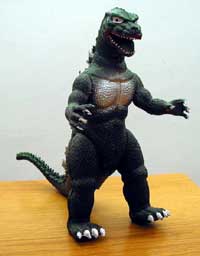 Books and prints are not the only form in which Japanese monster culture
has received material, and mercantile, expression. Wealthy townsmen in Tokugawa-period
cities, for example, prized netsuke, or purse toggles, which artisans
carved into the shape of folkloric monsters, ghouls, and demons. In the
twentieth century, Godzilla and his fellow kaijû offered similarly
rich commercial opportunities. Among the most prolific of all kaijû goods are models or other toys made from plastic or other materials (see,
for example, ITEM
28, top shelf), sometimes mechanized, as is the case with the hatching
Books and prints are not the only form in which Japanese monster culture
has received material, and mercantile, expression. Wealthy townsmen in Tokugawa-period
cities, for example, prized netsuke, or purse toggles, which artisans
carved into the shape of folkloric monsters, ghouls, and demons. In the
twentieth century, Godzilla and his fellow kaijû offered similarly
rich commercial opportunities. Among the most prolific of all kaijû goods are models or other toys made from plastic or other materials (see,
for example, ITEM
28, top shelf), sometimes mechanized, as is the case with the hatching
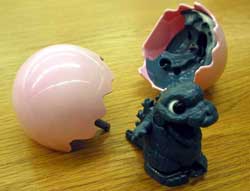 Godzilla (ITEM
27) on the top shelf. Notably, it was an American toy manufacturer,
Aurora, not a Japanese, that marketed the first Godzilla model in 1964.
By the early 1970s, Godzilla, along with Dracula and Frankenstein, had secured
a prominent and probably permanent place in the plastic pantheon of American
"movie monsters," making for a distinctly multicultural lineup (1972 magazine
ad,
Godzilla (ITEM
27) on the top shelf. Notably, it was an American toy manufacturer,
Aurora, not a Japanese, that marketed the first Godzilla model in 1964.
By the early 1970s, Godzilla, along with Dracula and Frankenstein, had secured
a prominent and probably permanent place in the plastic pantheon of American
"movie monsters," making for a distinctly multicultural lineup (1972 magazine
ad,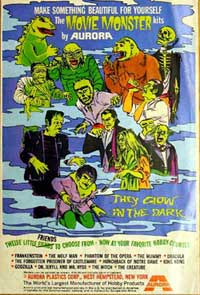 ITEM
30,
top shelf). Godzilla invaded American and Japanese homes also in such diverse
forms as eight-millimeter movies (ITEM
30, top shelf), phonograph records (ITEM
32, bottom shelf), pinback buttons (ITEM
29, top shelf), and keychains-cum-refrigerator magnets (ITEM
31,
top shelf). Kaijû commerce was by no means a phenomenon limited to
Japan and North America. The toy machine gun (ITEM
33) on the bottom shelf, which was likely made in the 1950s or 1960s,
comes from Argentina. Although, like the Taiwanese keychains above it, the
product was probably not officially licensed by Tôhô Corporation, the graphic
design on the box depicts what surely must be Godzilla in the midst of his trademark urban
rampage. The image of the neatly dressed matron fleeing the monster, firmly
clutching her handbag,
ITEM
30,
top shelf). Godzilla invaded American and Japanese homes also in such diverse
forms as eight-millimeter movies (ITEM
30, top shelf), phonograph records (ITEM
32, bottom shelf), pinback buttons (ITEM
29, top shelf), and keychains-cum-refrigerator magnets (ITEM
31,
top shelf). Kaijû commerce was by no means a phenomenon limited to
Japan and North America. The toy machine gun (ITEM
33) on the bottom shelf, which was likely made in the 1950s or 1960s,
comes from Argentina. Although, like the Taiwanese keychains above it, the
product was probably not officially licensed by Tôhô Corporation, the graphic
design on the box depicts what surely must be Godzilla in the midst of his trademark urban
rampage. The image of the neatly dressed matron fleeing the monster, firmly
clutching her handbag, 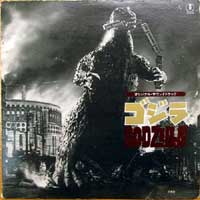 evokes some of the posters in the Kress Room next
door. In a classic Oedipal configuration, the boy to whom the toymakers
appealed presumably desires to brandish this gun so as to rid his world
of a menacing masculine figure who would claim possession of the mother.
But then again, sometimes a toy is just a toy.
evokes some of the posters in the Kress Room next
door. In a classic Oedipal configuration, the boy to whom the toymakers
appealed presumably desires to brandish this gun so as to rid his world
of a menacing masculine figure who would claim possession of the mother.
But then again, sometimes a toy is just a toy.
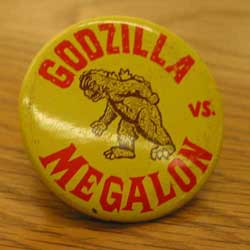 |
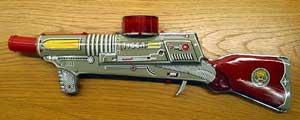 |
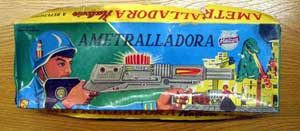 |
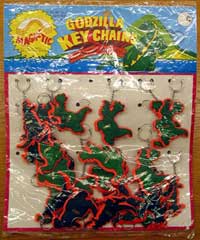 |
Display Case 8:
MONSTER
MERCHANDISE (II)
From a merchandising standpoint, the fact that monsters are creatures of
the imagination offers distinct commercial advantages. Because they do not
actually exist—or at least so we hope—monsters are available only
as representations. As such, they are eminently commodifiable, consumable,
and collectible. Moreover, there is hypothetically no limit to the number
of monsters that the imagination, and hence the monster industry, can create.
Simply put, monsters multiply. Paradoxically, they also divide, for, in
order to keep track of their proliferating numbers, it becomes necessary
to differentiate among them, to distinguish their characteristic features
and powers, to create, in effect, cultural order out of monstrous chaos.
A taxonomic knowledge of monsterdom can itself become a form of commodity.
It is a marketable asset that many generations of Japanese children, as
well as adults, have prized, and that entrepreneurs have been quick to capitalize
on. To know your monsters, perhaps even to own some, is bound to make you
a popular kid on the block.
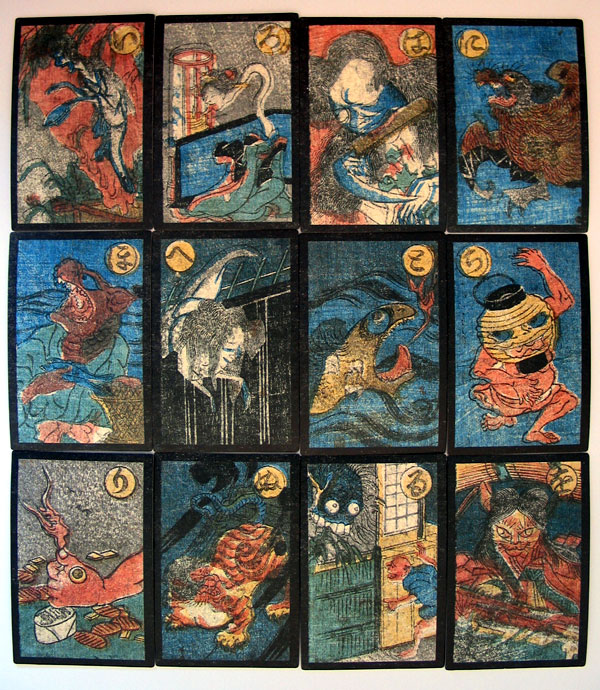 I
I
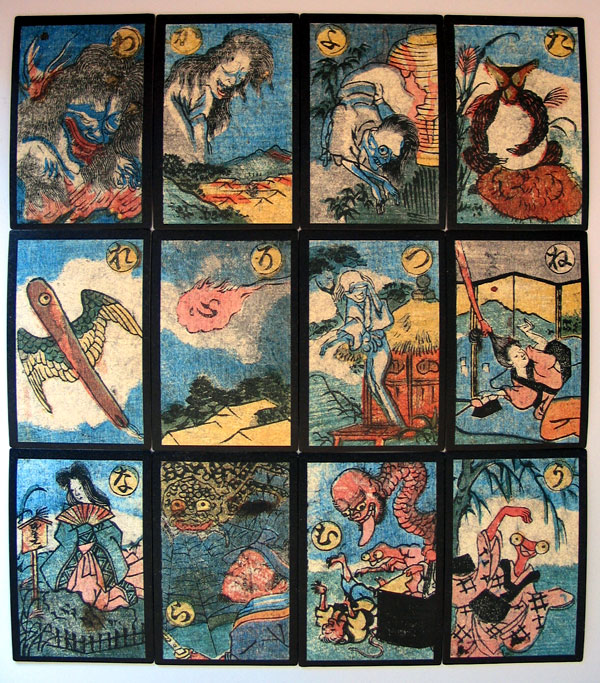
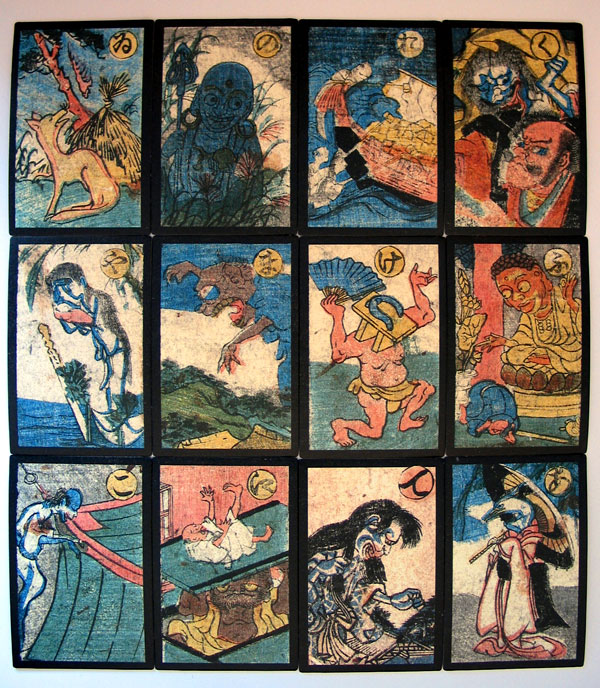
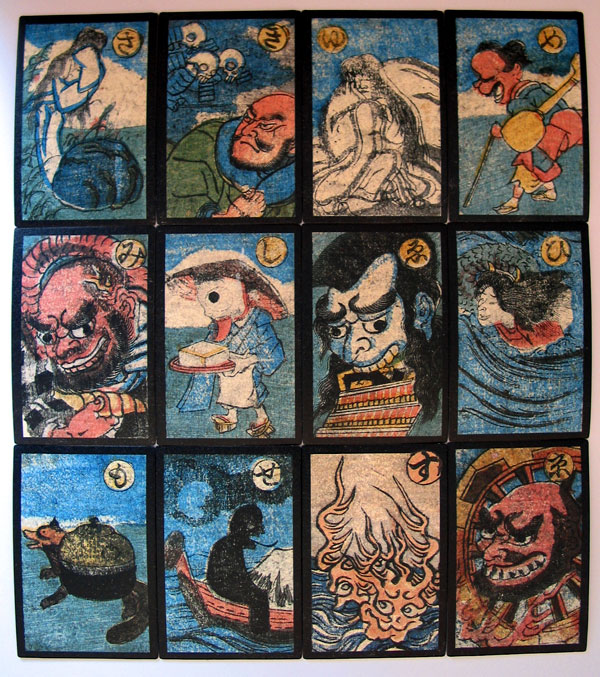 n Tokugawa-period Japan, one way of testing one's monster knowledge was
through the game of obake karuta. Obake means "ghost" or "monster,"
while karuta derives from the Portuguese name for Tarot cards, introduced
into Japan in the late sixteenth century. Players competed to snatch up
colorful monster cards matching clues read aloud by the master of ceremonies.
The individual or team who accumulated the greatest number of cards—there
was one for each "letter" of the Japanese syllabary—by the end of the
game was the winner. The cards displayed on the top shelf (ITEM 34 [GROUP
1][GROUP
2][GROUP
3][GROUP
4]) are reproductions of a set that was marketed in the latter half
of the Tokugawa period, perhaps in the early nineteenth century. The game
itself was commonly played as late as the 1910s or 1920s. Among the monsters
represented in this deck are several that feature elsewhere in the exhibition,
including a "dirt spider," a rubberneck, "ship ghosts," a "lantern
ghost," and a metamorphic badger (complete with large testicles) and
fox.
n Tokugawa-period Japan, one way of testing one's monster knowledge was
through the game of obake karuta. Obake means "ghost" or "monster,"
while karuta derives from the Portuguese name for Tarot cards, introduced
into Japan in the late sixteenth century. Players competed to snatch up
colorful monster cards matching clues read aloud by the master of ceremonies.
The individual or team who accumulated the greatest number of cards—there
was one for each "letter" of the Japanese syllabary—by the end of the
game was the winner. The cards displayed on the top shelf (ITEM 34 [GROUP
1][GROUP
2][GROUP
3][GROUP
4]) are reproductions of a set that was marketed in the latter half
of the Tokugawa period, perhaps in the early nineteenth century. The game
itself was commonly played as late as the 1910s or 1920s. Among the monsters
represented in this deck are several that feature elsewhere in the exhibition,
including a "dirt spider," a rubberneck, "ship ghosts," a "lantern
ghost," and a metamorphic badger (complete with large testicles) and
fox.
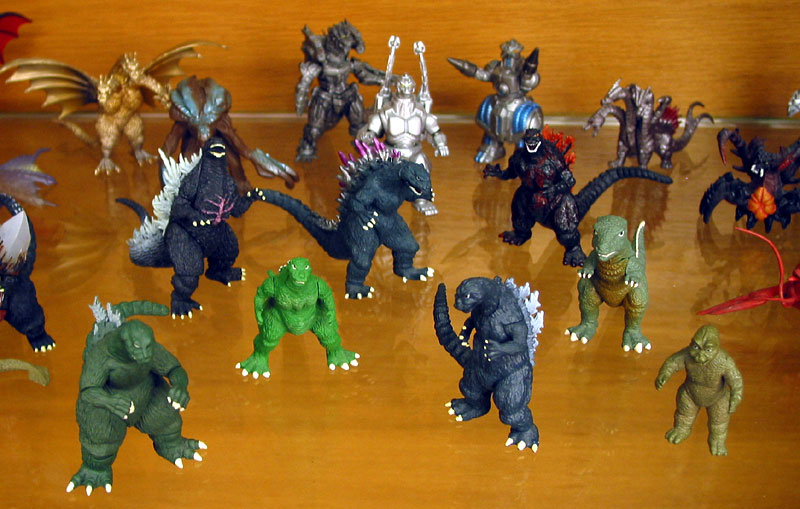 The principles of multiplication and taxonomization that fueled early-modern
monster commerce may be recognized also in its twentieth-century equivalent.
The giant movie monsters (kaijû) that Tôhô Corporation and other
Japanese film studios developed beginning in the 1950s boasted clearly distinguishable
traits and powers—from their outward appearance to their weapons of
choice to their signature sounds—and to mistake Rodan for Ghidrah would
be a ghastly faux pas in certain juvenile circles. One could also
"own" them, whether in the form of trading cards or picture books or three-dimensional
figures like the set that is laid out on the middle shelf (ITEM
35).
The principles of multiplication and taxonomization that fueled early-modern
monster commerce may be recognized also in its twentieth-century equivalent.
The giant movie monsters (kaijû) that Tôhô Corporation and other
Japanese film studios developed beginning in the 1950s boasted clearly distinguishable
traits and powers—from their outward appearance to their weapons of
choice to their signature sounds—and to mistake Rodan for Ghidrah would
be a ghastly faux pas in certain juvenile circles. One could also
"own" them, whether in the form of trading cards or picture books or three-dimensional
figures like the set that is laid out on the middle shelf (ITEM
35).  Among the figures are several that hearken back to earlier manifestations
of Japanese monster culture, including dragonlike beasts such as Godzilla (front center) and Ghidrah (left rear), and scary bugs such as Mothra (along the right edge).
Among the figures are several that hearken back to earlier manifestations
of Japanese monster culture, including dragonlike beasts such as Godzilla (front center) and Ghidrah (left rear), and scary bugs such as Mothra (along the right edge).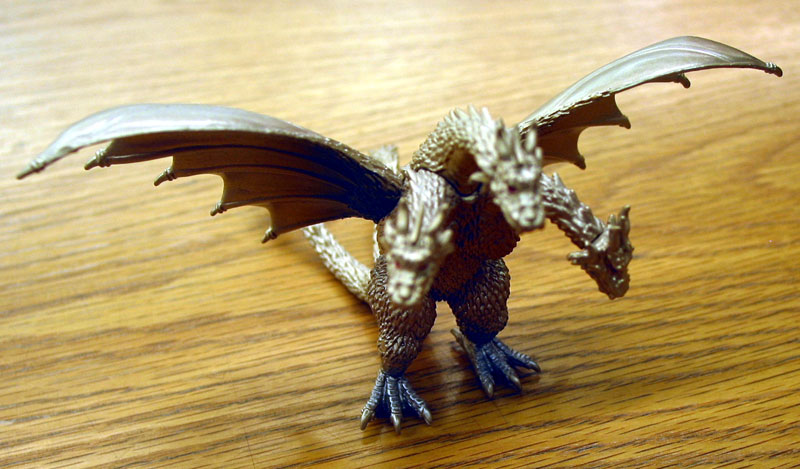
More recently, the same taxonomic impulse has found expression in the Pokémon
phenomenon. Around the world, children clamor for trading cards (see ITEM
36, bottom shelf) bearing the image of Pikachû and his fellow "pocket
monsters," animated creatures that made their debut as Game Boy characters
in 1996. The cards, which are marketed in Japanese, English, and many other
languages, provide vital statistics concerning the featured monsters, including
their special powers and metamorphic abilities. Over the past seven years,
a television series and six Pokémon movies have captured a larger global
audience than Tôhô's Godzilla flicks did over the last half-century. Testifying
to the underlying continuity in Japanese monster culture, the corporation
that was responsible for creating Pokémon is Nintendô, a company originally
founded in 1889 as a manufacturer of gaming cards (hanafuda) similar
to the obake karuta displayed on the top shelf. Some of Nintendo's
"pocket monsters" draw on much older iconographic traditions. For example, Ho-oh or Sacred Wing (bottom row) is modeled after a phoenixlike bird (hôô)
that was known to Japanese for well over a millennium and originated in
the Chinese classics.
SEE MORE OF THE EXHIBITION IN ROOM 1 and ROOM 3
Godzilla (R), all related characters and the character designs are trademarks
of Toho Co., Ltd.
© Gregory M. Pflugfelder